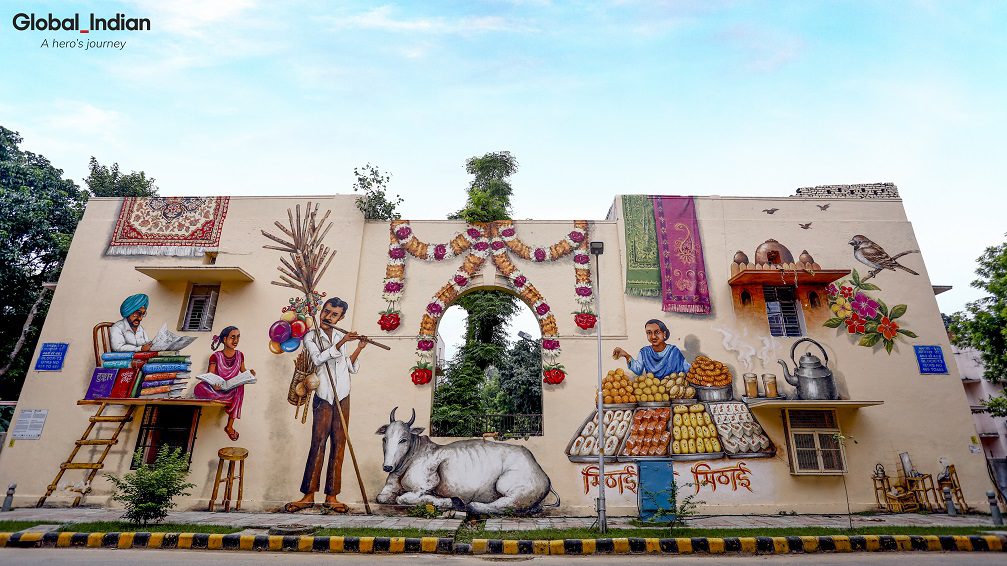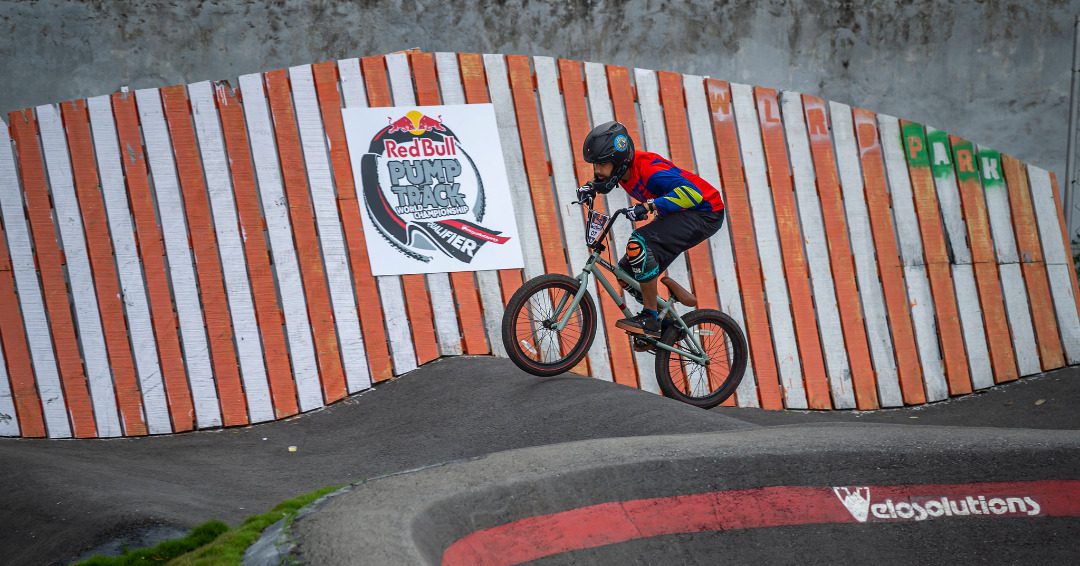(September 19, 2021) The sun is peeping through the curtains longing to know if 20-year-old Manish Singh is happy to bask in its warmth. It finds him languidly sprawled on his bed, listening to the commotion outside his quiet neighborhood. Armed with tripods and light reflectors, a string of chirpy photographers and his Indian art have momentarily taken over the colossal wall art right outside his block. Resting against the metal door of his ground floor house in shorts and blue t-shirt, Singh finds himself gazing at a new bunch of visitors every few minutes admiring the breathtaking murals in the leafy lanes of his colony. “This is a common sight now. So much has changed in Lodhi Colony, all thanks to these murals. A few years ago, we were just another residential colony but now the art has given this neighborhood a fresh lease of life. People from all walks of life often find themselves admiring these murals that have made Lodhi Colony quite popular,” says Singh, a Delhi University student.
Pop colors, asymmetric patterns and thought-provoking themes is what draws hundreds of Dilliwallas to one of the hottest spots in the capital. A true celebration of street Indian art in its purest form, Lodhi Art District is an open art gallery that has grabbed the attention of every art lover.
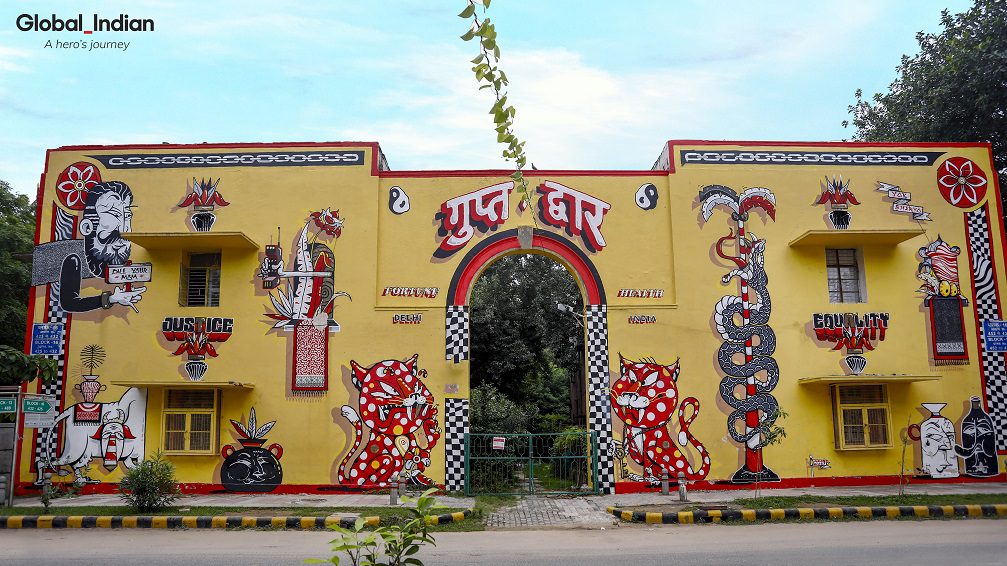
Gupt Dwar mural made by Singaporean artists Yok and Sheryo
Nestled between the hip Meherchand Market – that’s lined with designer boutiques and eateries on one side – and the unadorned modest shops of Khanna Market on the other, Lodhi Colony is the last residential area of Lutyens Delhi to be built by the British. The soaring arches and the plain tall walls of these two-storeyed structures have turned into the perfect canvases for artists from across the globe to splash their creativity, all thanks to St+Art India Foundation, the NGO behind the government colony’s glammed-up avatar.
What began in 2015 as a three-wall experiment has now taken over the seven-kilometer area of Lodhi Colony that’s adorned with some of the best public Indian art in the city. The idea of challenging the conventional notion of practicing art and encouraging a culture where artists are making cities their studio is what made St+Art Foundation take their first big step into street art. “For the longest time, art environment seemed to have a high gaze. The idea was to take art out of gallery spaces and bring it closer to the community. When we first began the project, we worked with the community asking them what it was that they would want to see and how they wanted to see it. We engaged with the community to find its pulse and then translated it into art work,” says Arjun Bahl, co-founder of St+Art India Foundation.

Trans Lives Matter by Aravani Art Project
With art mostly restricted to closed spaces, St+Art Foundation has been on a mission to make it accessible to the common people. “People are often intimidated at the thought of visiting an art gallery. It’s the elite that has dominated art spaces but we wanted to change that by bringing inclusivity. This idea led to the birth of St+Art Foundation. Initially, when we started the journey of bringing art to the people, it was without any formula. But a year and a half into it, we started looking at the city as an organism that is fragmented and diverse,” Giulia Ambrogi, co-founder and curator at St+ Art India Foundation chimes in.
This impressive initiative of bringing Indian art to the people gave birth to Lodhi Art District that now has over 50 murals. If one wall has graffiti artist Harsh Raman Singh Paul‘s Crazy Katha Twins bringing alive the beautiful amalgamation of Kathakali and street art, another has the endangered Asian elephants painted into Lodhi Colony’s landscape by Majili Art Forum. “Each wall has a locally-rooted meaning. We invited artists from different genres as diversity was the key element in the project,” adds Ambrogi, who joined forces with Bahl and three others to launch the Indian street art movement.
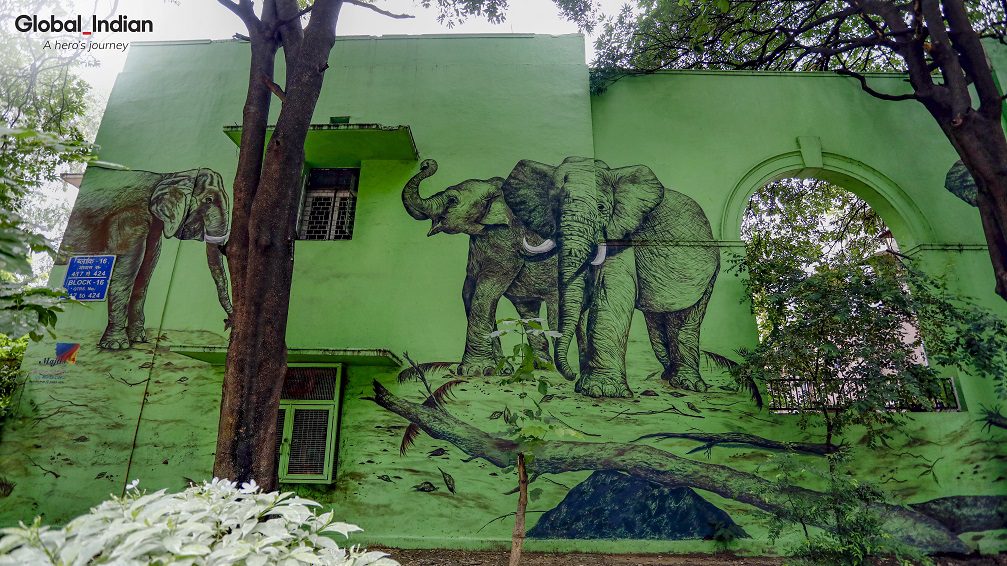
Gracious Heritage by Majili Art Forum
Every corner of Lodhi Colony holds a surprise for its visitors. If one turn leads you to a mother figure with diverse manifestations, the other draws you in by being a reminder of our flawed relationship with Nature. It’s the mesmerizing fusion of color, patterns and themes that have enveloped the streets of Lodhi, all thanks to a wide array of home grown and international artists. It’s their brush strokes that have cast magic on the otherwise plain walls bringing them alive.
If New Zealand artist Aaron Glasson‘s The Sacrosanct Whole is a tribute to the Indus Valley civilization, Colors of the Soul by a Mexican artist Sankoe signifies the diversity of the people of Lodhi Colony. “We keep in mind the characteristic of the space and bring in artists who can activate a dialogue. Every art work should make you feel. We try to create an orchestra with the sound of the city, the imagination of the artists and the love of the people,” adds Ambrogi.
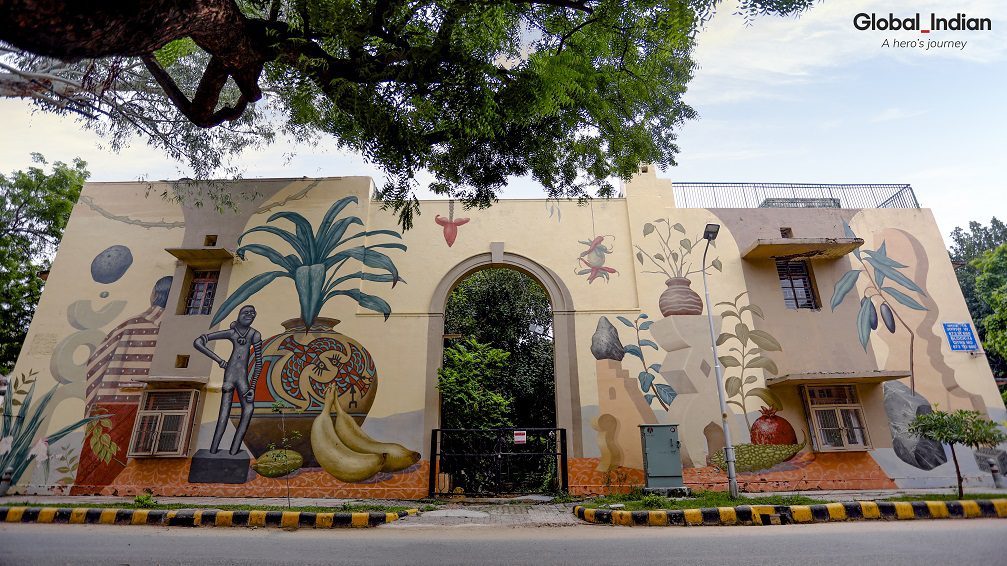
The Sacrosanct Whole by New Zealand artist Aaron Glasson.
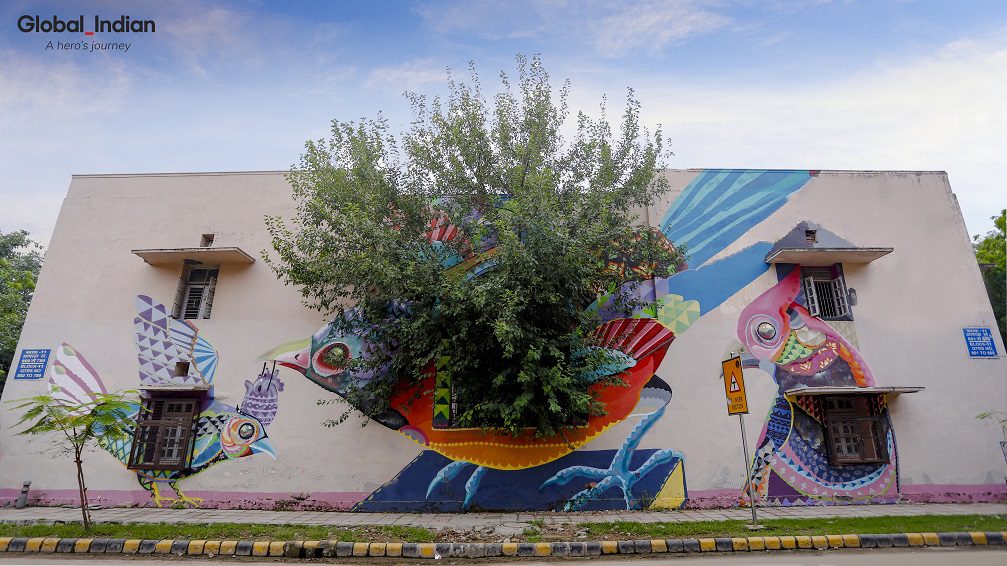
Colors of the Soul by Mexican artist Sanoke.
One such mural that is typically Dilli finds itself tucked in the beautiful lane of Block 13. With a balloon seller on one side, a mithaiwali on the other, and a cow in between, this wall art by Singaporean artist Yip Yew Chong is an appealing homage to Lodhi Colony. Ambrogi, who learnt about Chong on her visit to Singapore in 2017, knew that she had found the perfect artist for the Lodhi Indian art project. “His work is not predominantly featured online. But the moment you step into Singapore, you get to see his work almost everywhere. When we asked him to paint for us, he walked around the entire colony to get a feel of the place and ended up making this wonderful mural which is so Delhi,” recalls Ambrogi.
For her, art is much more than colors and designs. It is something that stirs up something inside of you, and to create the right impact she patiently spends hours looking for the right talent. From keeping herself updated on the emerging new artists to calling out for talent on Instagram, Ambrogi is always on her toes to add something new to the street art movement.
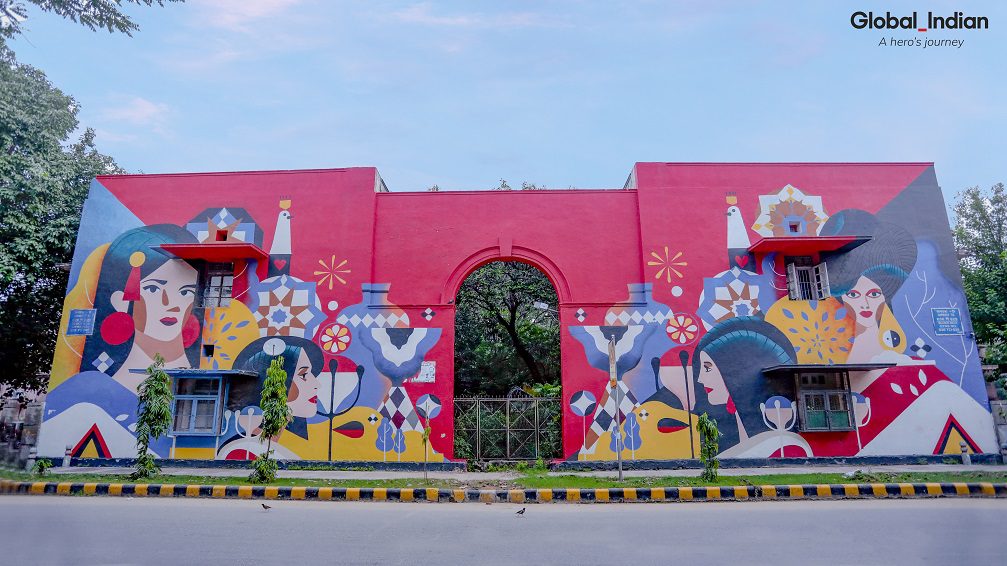
Ode to Feminity by Mumbai artist Sajid Wajid Sheik
When Lodhi Art District was in its nascent stage, it was the sheer beauty of the colony that grabbed her attention. “Being the last colony in Delhi to be built by the British, the houses have a certain charm to them with their soaring arches, the tall walls, courtyards, and beautiful sidewalks. So while crossing the area many a times, it stayed with us since it isn’t a gated colony it is accessible to people. Since the area belongs to the government, we found it to be clean and without any signboards. A perfect haven for art lovers without any sort of distraction,” says the curator.
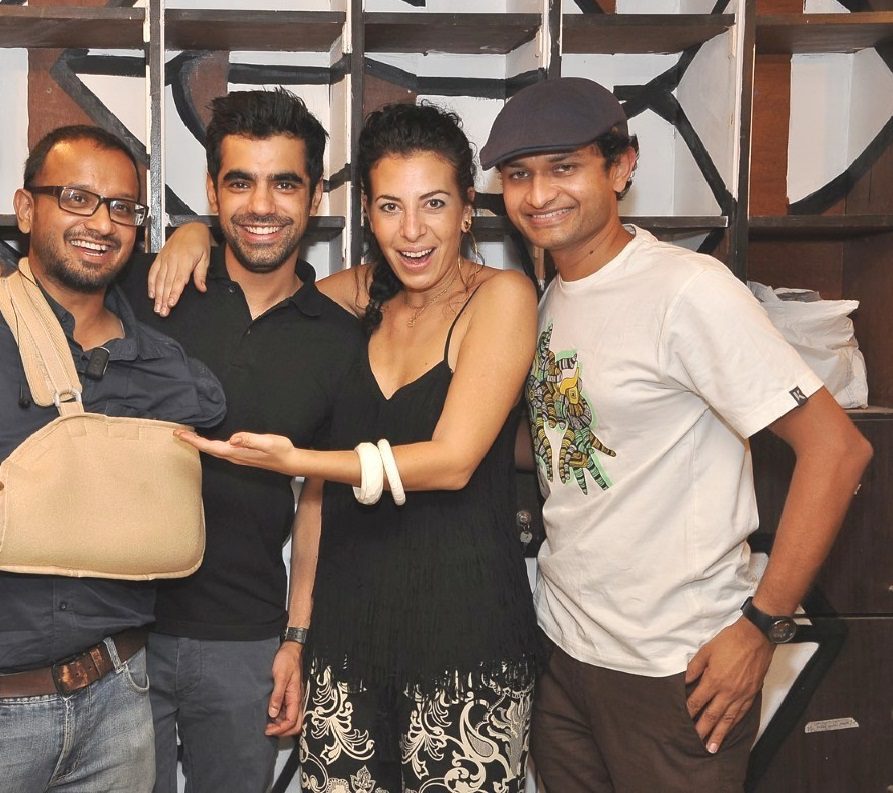
Thanish Thomas, Arjun Bahl, Giulia Ambrogi and Hanif Kureshi are the co-founders of St+ Art India Foundation.
It’s been six years since this mega project was launched and the journey has been quite a roller coaster for the Foundation, for it had to face a few challenges to start something that was unheard of in Delhi. Bahl reveals, “There were initial hiccups as nothing on this scale was done in Delhi. It took us a while to understand under whose jurisdiction Lodhi Colony fell and from whom we needed to seek permission. While there was initial hesitation things started falling in place once they understood the purpose of the project.”

Nature’s Arch and Visions of Altered Landscapes by Canadian artist Li-Hill
With the pandemic putting the entire world in lockdown, things started to look a bit awry for Lodhi Art District. With no new murals for a while now, Delhites are waiting with bated breath to see some new art pop up on one of the walls. Bahl is feverishly working with his team to pack a surprise soon as he promises to restart work at Lodhi Art Colony by October 2021. “We would be doing more work in Delhi. In fact, we have plans for restoring the art that has been marred by the weather. We are coming soon. Hang in there.”

